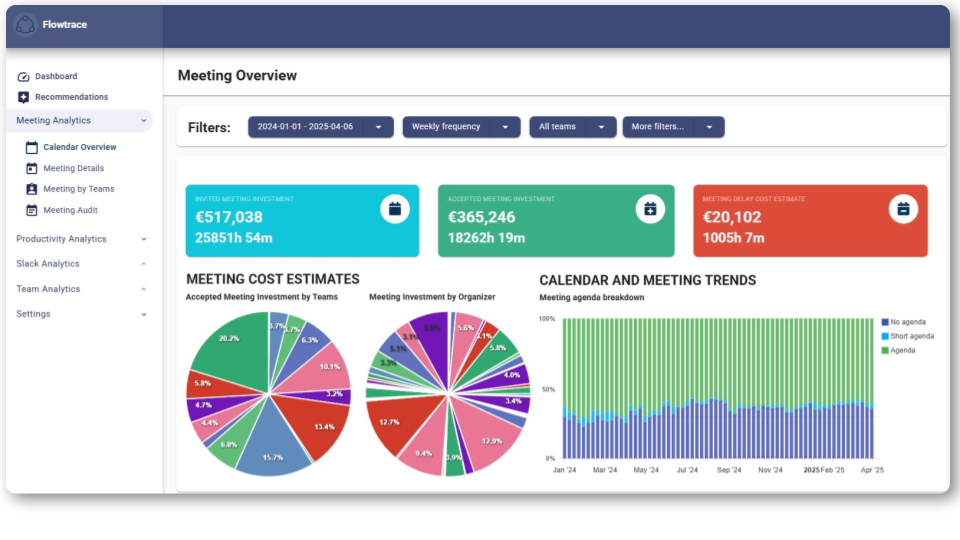Meetings are at the heart of how organizations collaborate, make decisions, and move projects forward. Yet for many teams, meetings have become synonymous with wasted time, burnout, and a creeping sense of inefficiency. Leaders often find themselves pulled into endless calls, while employees struggle to carve out time for focused work.
A healthier meeting culture is not about eliminating meetings altogether. Instead, it is about creating intentional, purposeful spaces where collaboration thrives, decisions are made, and every participant feels their time is respected. When done well, meetings become a powerful driver of productivity, innovation, and engagement.
This article explores what makes a meeting culture unhealthy, how to transform it, and the measurable business benefits of doing so.

Why Meeting Culture Matters
Meeting culture refers to the shared behaviors, norms, and expectations around how meetings are planned, run, and followed up. It goes beyond scheduling logistics, shaping how teams interact and make progress together.
The impact of poor meeting culture is significant. When meetings are frequent, unstructured, or poorly attended, organizations pay the price in lost productivity, slower decision-making, and disengaged employees. For leaders, this translates into higher costs, stalled execution, and a frustrated workforce.
On the other hand, improving your meeting culture can dramatically increase productivity. Teams that approach meetings strategically find they reclaim hours of focused work each week while also strengthening cross-functional collaboration.
Signs Your Meeting Culture is Unhealthy
 Before you can improve, you need to recognize the warning signs of a problematic meeting culture. Common symptoms include:
Before you can improve, you need to recognize the warning signs of a problematic meeting culture. Common symptoms include:
- Too many recurring meetings without clear purpose: Meetings that happen out of habit rather than necessity.
- Decisions rarely made inside the meeting: Discussions drag on, but action points are deferred.
- Participants unclear on roles and responsibilities: Attendees leave unsure of who owns next steps.
- Lack of follow-up or accountability: Action items are documented but rarely revisited.
- Back-to-back scheduling: Teams have little time for deep work, reflection, or preparation.
If these issues sound familiar, your team is likely stuck in a cycle of reactive collaboration rather than intentional communication.
Core Principles of a Healthy Meeting Culture
A healthier meeting culture rests on four key principles:
1. Clarity
Every meeting should have a clear agenda, a defined purpose, and an expected outcome. Whether it is a status update, a brainstorming session, or a decision-making forum, participants should know why they are there and what success looks like.
2. Efficiency
Healthy meetings respect time. That means limiting the length of discussions, inviting only essential participants, and canceling calendars that lack purpose. Efficiency is about creating value, not filling calendars.
3. Respect
Meeting culture reflects how organizations respect their people. This includes acknowledging different time zones, protecting focus blocks for deep work, and ensuring that all voices are heard. Respecting time and input builds trust.
4. Balance
Not every conversation requires a meeting. Healthy meeting cultures balance synchronous collaboration with asynchronous tools such as shared documents, project boards, or chat platforms. Meetings should be reserved for tasks that truly benefit from live interaction.
Practical Steps to Build Healthier Meetings
Redesign Meeting Structures
Many organizations fall into the trap of holding meetings by default. To break the cycle, start by redesigning how meetings are structured:

- Introduce an agenda-or-cancel policy: If a meeting lacks a documented agenda, it should be rescheduled or canceled.
- Define outcomes upfront: Replace vague objectives with specific deliverables, such as “decide budget allocation' or “finalize product roadmap.'
- Rotate roles: Assign facilitators, note-takers, and timekeepers so responsibility and engagement are shared.
Encourage Asynchronous Collaboration
Not everything needs to be discussed in real time. By shifting routine updates and status checks to asynchronous channels, you free meetings for higher-value activities.
- Use project management tools to track progress instead of weekly check-ins.
- Share pre-read materials in advance, so meetings focus on decision-making.
- Leverage recorded updates when live attendance is not essential.
Optimize Time and Participation
A healthier meeting culture thrives on brevity and focus.
These small adjustments create room for deep work and reduce fatigue.
Leverage Data and Feedback
Meeting culture can and should be measured. Use meeting analytics to track how much time teams spend in meetings, identify patterns of inefficiency, and highlight opportunities for change.

Data-driven insights allow leaders to make objective improvements rather than relying on assumptions. If you need a quick starting point, a calendar data audit highlights waste in days.
The Business Impact of Healthier Meetings
Investing in a healthier meeting culture is not simply a matter of employee well-being. It produces tangible business benefits:
- Faster decision-making: Structured meetings reduce delays and clarify ownership.
- Higher employee engagement: Respectful meeting practices improve satisfaction and reduce burnout.
- Greater productivity: Teams reclaim hours of focused work, driving better outcomes.
- Lower costs: Reducing unnecessary meetings cuts the hidden cost of wasted hours.
According to Harvard Business Review, executives spend nearly 23 hours a week in meetings, up from less than 10 hours in the 1960s. Much of this time is neither efficient nor effective. A McKinsey study further found that organizations waste up to 30 percent of their meeting time due to poor structure and unclear outcomes.
These meeting statistics highlight why meeting culture is a business-critical issue. The opportunity cost of unhealthy meeting habits is enormous, while the potential gains from healthier practices are immediate and measurable.
Build a Healthy Meeting Culture Today
Building a healthier meeting culture is not about eliminating meetings but about transforming them into purposeful, efficient, and respectful spaces for collaboration. By focusing on clarity, efficiency, respect, and balance, organizations can shift from reactive calendars to intentional communication.
The result is not only fewer wasted hours but also stronger collaboration, faster decisions, and a more engaged workforce. In an era where time is one of the most valuable organizational resources, a healthier meeting culture becomes a competitive advantage.

Frequently Asked Questions - Meeting Culture